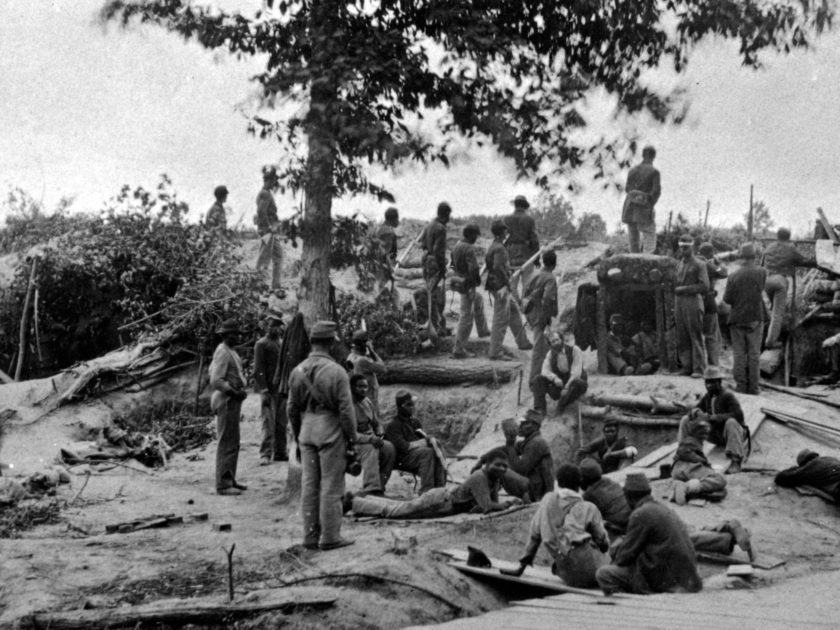By Candice Zollars
On July 6, 1863, in the wake of the Gettysburg Campaign, Frederick Douglass proclaimed: “Young men of Philadelphia, you are without excuse. The hour has arrived, and your place is in the Union Army. Remember that the musket—the United States musket with its bayonet of steel—is better than all mere parchment guarantees of liberty.”
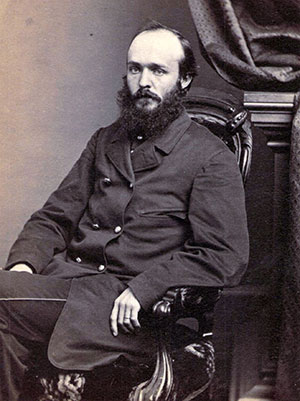
Recruitment for black troops in Pennsylvania thus began in earnest, and many prominent public figures made broad appeals to Philadelphia’s men of color to enlist.
To accommodate the influx of new troops, the federal government established Camp William Penn, 10 miles north of downtown Philadelphia. Camp William Penn was the first and largest federal training ground for black soldiers in the North. Eleven regiments of U.S. Colored Troops trained there between 1863 and 1865.
Not all Philadelphians were pleased with the project. Two days after Douglass’s speech, local attorney and essayist Sidney George Fisher recorded in his diary, “The orators claim equality for the Negro race, the right of suffrage, &c. All this is as absurd as it is dangerous.”
The men of the 6th trained at Camp William Penn from July to September 1863. The camp’s commander, Col. Louis Wagner, was a veteran of the 88th Pennsylvania Infantry who had suffered a wound and capture by Confederates at the Second Battle of Bull Run in August 1862. After being exchanged, he rejoined the 88th and fought at Chancellorsville in May 1863. But his wound reopened and he was transferred to the Invalid Corps, which was later redesignated the Veteran Reserve Corps.

On October 12, 1863, the Philadelphia Inquirer praised Wagner’s popularity, noting, “he is universally beloved” by the men of the 6th and also had “the confidence of the officers.”
At least one officer disagreed with this assessment. Capt. John McMurray of Company D, a 25-year-old teacher and carpenter from western Pennsylvania, wrote after the war that he “never had an overflowing feeling of admiration for him.” McMurray, who had previously served in the 135th Pennsylvania Infantry and the 57th Pennsylvania Militia Infantry during the invasion of the state by Gen. Robert E. Lee and the Confederate Army of Northern Virginia, recalled his first encounter with Wagner. The colonel grilled McMurray about military affairs for some 15 minutes, while three or four other officers watched. “The interview may have been satisfying in some way to Colonel Wagner,” wrote McMurray, “but it was not pleasant to me.”
From Philadelphia to the Peninsula

On Oct. 14, 1863, the 6th left Philadelphia for the Virginia coast and Fortress Monroe, where the regiment joined Gen. Benjamin F. Butler’s Army of the James. As the soldiers marched through the streets, one Philadelphia reporter stated, “They made a brilliant appearance.” The men and officers occupied the majority of their time on mundane tasks—performing fatigue and picket duty, guarding prisoners, tending horses, distributing rations and caring for the wounded. Nevertheless, one officer wrote with evident pride to a Philadelphia newspaper on Feb. 18, 1864, “Their clothes are dirtier and rustier, but the men stand more erect, and my regimental line, now, is almost motionless.”
The routine was interrupted one day while the regiment encamped on the bluffs overlooking the York River. Capt. McMurray was summoned after Pvt. Thomas W. Hamilton of Company F refused to help cut a path from camp to a nearby spring. McMurray ordered Hamilton to fall in with the others, but he refused to do so. Hamilton laid down on the ground before the guard tent instead. McMurray ordered another officer to “buck and gag” Hamilton, at which point McMurray later recalled, “Hamilton sprang up, drew a razor which he had concealed about him, and bran[d]ishing it in his hand rushed upon me with murder gleaming from his eyes.” McMurray quickly responded, grabbing a club from the ground and striking him square on the head. Hamilton “fell to the ground like a bullock,” and was quickly tied up.
One hundred soldiers from the regiment gathered around the guardhouse, “filled with eager excitement.” Worried that the regiment might mutiny, one officer handed McMurray a pistol, telling him, “Captain, take this revolver; you may need it.” McMurray pointed the revolver at “the rapidly increasing number of soldiers” and explained what had transpired. He then ordered the men to return to their quarters. The show of force convinced the agitated soldiers to return to their tents.
Battle Tested on the Front Lines of Petersburg

In May 1864, the 6th moved northwest toward Petersburg, Va., where it constructed trenches in the ever-expanding complex of frontline defenses. Chaplain Jeremiah Asher lamented that the men were not receiving as much religious instruction as they had had during the winter months. “The men have been working on the fortifications day and night,” he reported, “not excepting the Sabbath.”
The regiment received its baptism under fire on June 15 when it participated in an assault on a section of Confederate earthworks near Petersburg. Capt. Harvey J. Covell of Company B described the fighting in a letter to his wife as “about as hot a place as I ever saw.” As Covell hid “behind a little tree a shell struck within a few feet and … exploded among us.” The men found that they could dodge the artillery fire “if it struck the ground before it reached us as it usually would.” One shell “exploded a few feet in front of me the balls and fragments flying all around me,” he wrote. Covell emerged unscathed from the engagement.
On Sept. 29, the 6th participated in an assault on the Richmond defenses at New Market Heights. The regiment suffered heavy casualties—209 of 367 engaged, or a loss of 57 percent. Among the dead was Pvt. Hamilton, who had drawn a razor on Capt. McMurray in camp a few months earlier. The wounded included Capt. Robert B. Beath, who endured the amputation of his right leg. At one point during the fight, McMurray found Adjutant Charles V. York lying by a path in excruciating pain from a wound. McMurray took note of York’s position and continued on with his command.
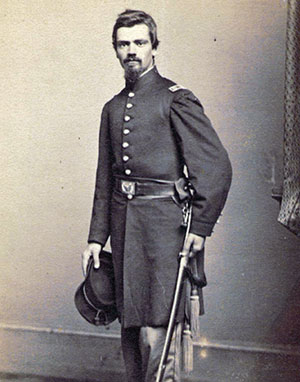
McMurray eventually returned and discovered that York had died, and that his body had been stripped of everything except his undergarments. “His uniform, a good one, had been taken by the Johnnies, with all he had about him, including the money in his pocket, his watch, and the other things in his pockets,” McMurray recalled. All that remained to identify York’s remains was a slip of paper with his name, rank, and regiment “pinned to the bosom of his shirt.”
Maj. Gen. Butler praised the conduct of those in his command who fought at New Market Heights: “In the charge on the enemy’s works,” Butler noted, “better men were never better led, better officers never led better men. With hardly an exception, officers of colored troops have justified the care with which they have been selected.” He added, mindful of Northern critics of black soldiers in blue, “A few more such charges, and to command colored troops will be the post of honor in the American armies. The colored soldiers, by coolness, steadiness, and determined courage and dash, have silenced every cavil of the doubters of their soldierly capacity, and drawn tokens of admiration from their enemies.”
In North Carolina at the War’s End
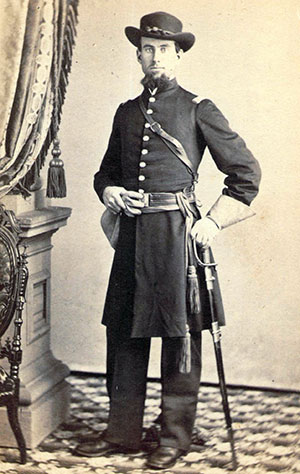
The 6th mustered out of the army in September 1865. It suffered about 40-percent casualties of the roughly 1,000 men who had joined two years earlier. Returning to Philadelphia, the officers of the 6th adopted a resolution lauding the men as “brave, reliable, and efficient” soldiers who should “be fully recognized as equals, [and] honorable and responsible citizens.”
In 1892, Lt. Joseph H. Golding praised the men who had served under him for their courage in battle. “What did it matter that his face was black? What more could he have done to prove himself a man, as true as any who walks the earth?” he asked. The men of the 6th had done their duty “to the utmost, even to the laying down of life for us, for the flag, [and] for the perpetuation of the grandest nationality the sun shines upon.”
Photographs from the collection of Joyce Werkman, on loan to the Camp William Penn Museum, La Mott, Pa. (usct.org).
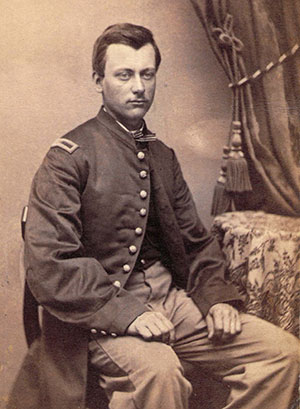
Sources: James M. Paradis, Strike the Blow for Freedom: The 6th United States Colored Infantry in the Civil War; Horace Montgomery, “A Union Officer’s Recollection of the Negro Soldier,” Pennsylvania History 28 (April 1961); Edwin S. Redkey, “Black Chaplains in the Union Army,” Civil War History 33 (December 1987); Harvey Covell to wife, June 20, 1864, Harrisburg CWRT Collection, U.S. Army Military History Institute; John McMurray, Recollections of a Colored Troop; Christian Samito, Becoming American under Fire: Irish Americans, African Americans, and the Politics of Citizenship During the Civil War Era.
Candice Zollars graduated from Christopher Newport University with a degree in American Studies in May 2014. She lives in Chesapeake, Va.
SPREAD THE WORD: We encourage you to share this story on social media and elsewhere to educate and raise awareness. If you wish to use any image on this page for another purpose, please request permission.
LEARN MORE about Military Images, America’s only magazine dedicated to showcasing, interpreting and preserving Civil War portrait photography.
VISIT OUR STORE to subscribe, renew a subscription, and more.

